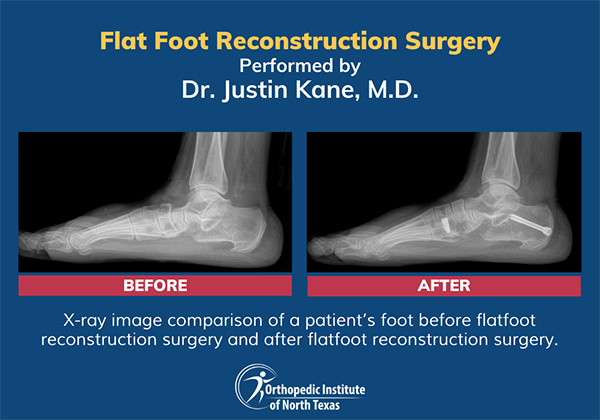Flat Foot Reconstruction for Restoring Mobility
Flatfoot is a condition caused by the collapse of the foot arch, bringing the entire sole into contact with the ground. Many people get flatfoot as they age, which can cause pain and disability when they stand or walk. Though surgery is rarely required, Flatfoot Reconstruction Surgery may be necessary.
What Is Flatfoot Reconstruction Surgery?

Flatfoot Reconstruction Surgery is a surgical technique used to correct a collapsed arch by treating the posterior tibialis tendon that supports the foot's arch.
The two leading techniques for Flatfoot Reconstruction Surgery are soft tissue reconstruction and fusion surgery.
What Is Soft Tissue Reconstruction Surgery for Flatfoot?
Soft tissue surgery is a reconstructive procedure that repairs the ligaments, muscles, and tendons in the foot. It is performed according to the following guidelines:
- Reconstructing the posterior tibialis tendon by using another tendon in the foot to recreate the arch
- Repairing the spring ligament complex to restore its support of the foot's medial arch
- Performing an osteotomy (bone cut) through the calcaneus to realign the heel
- Performing an osteotomy (bone cut) through the middle of the foot to restore the arch
What Is Fusion Reconstruction Surgery for Flatfoot?
Fusion surgery, also known as arthrodesis, is permanently fusing the bones and joints of the foot to strengthen and support the foot. A triple arthrodesis fuses the talus, calcaneus, and navicular. It is a common approach that fuses some or all of the bones that comprise the foot's arch.
Surgery involves creating one or two incisions in the foot to access the joints and stiffening them with screws, plates, or grafted bone from your heel or pelvis.
What Are the Differences Between Soft Tissue and Fusion Surgery for Flatfoot Reconstruction?
Here are some of the notable differences between these two types of flatfoot surgery:
- Soft tissue surgery for flat feet primarily involves the lengthening or replacing of tendons.
- Fusion surgery uses fixation hardware, like screws and plates, to immobilize joints in your foot.
- Soft tissue surgery might be a good choice if your flat feet are caused by weakened soft and connective tissues.
- Fusion surgery could be more appropriate if your flat feet have structurally deteriorated and become rigid with rearfoot arthritis.
- Soft tissue surgery strengthens your foot and enables it to move more normally.
- Fusion creates a more appropriate alignment of your foot by fusing one or more joints.
Another option is a combination of soft tissue and fusion procedures to achieve alignment and restoration of function. We may also choose to perform osteotomies, which involve cutting and grafting bone, to achieve the best result for your feet.
What Happens After Flatfoot Surgery?
Whether it is soft tissue or fusion surgery, Flatfoot Reconstruction Surgery is usually an outpatient procedure, though some patients may stay the night depending on recovery speed. The patient receives a foot cast to stay immobilized, and may use crutches after two weeks to move around as needed. The patient will need to avoid putting weight on the foot for at least six weeks post-surgery. After six weeks, we will assess your progress and plan a physical therapy program to help you recover your foot's full range of movement.
Whether soft tissue or fusion, you have options for Flatfoot Reconstruction Surgery. But there is only one choice for the best: Orthopedic Institute of North Texas.
